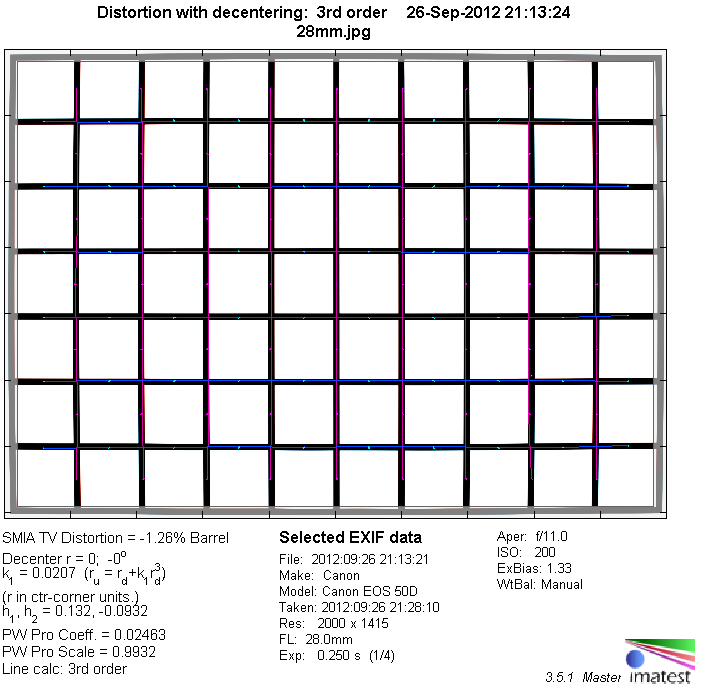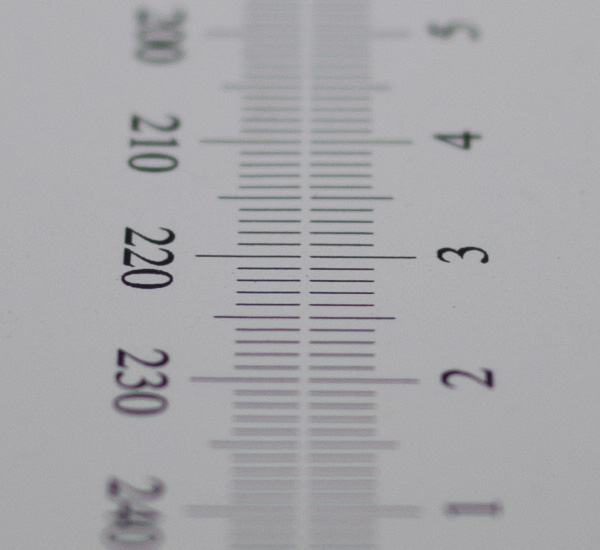|
Canon EF 28mm f/2.8 USM IS - APS-C Format Review / Lab Test - Analysis |
|
Lens Reviews -
Canon EOS (APS-C)
|
|
Page 2 of 2

Distortions
The lens produces a barrel distortion of just 1.3% which is rarely noticeable.

Vignetting
The EF 28mm f/2.8 USM IS is a full format lens so it enjoys a sweet spot advantage on APS-C cameras. However, there's still a pronounced light falloff of ~1EV (f-stop) at max. aperture. However, the issue is basically gone from f/4 onward.

MTF (resolution)
As to be expected from a prime lens, the resolution characteristic is impressive. The center sharpness is great followed by very good borders and extreme corners - even at f/2.8. The peak performance is already reached at f/4 with an outstanding center and a very good to excellent outer image region. Diffraction effects start to have a limiting factor from f/8 onward but the lens remains easily usable at f/11. The field curvature (flatness of the focus field) is marginal.
The centering quality of the tested sample was very good.
Please note that the MTF results are not directly comparable across the different systems!
Below is a simplified summary of the formal findings. The chart shows line widths per picture height (LW/PH) which can be taken as a measure for sharpness.
If you want to know more about the MTF50 figures you may check out the corresponding Imatest Explanations
Chromatic Aberrations (CAs)
Lateral CAs (color shadows at the image borders) stay around an average pixel width of around 1px at the image borders. This is still low and usually nothing to worry about.

Bokeh
A moderately fast wide-angle lens may not be an obvious candidate for a bokeh test but you can achieve a shallow depth-of-field when choosing short focus distances.
The out-of-focus highlight rendition is pretty clean with only a slight outlining effect. There's basically no deterioration of the circular highlight shape towards in image border (on an APS-C DSLR).
 The quality of the general blur in the focus transition zone is pretty good. The foreground blur is a bit busy whereas the more critical background blur is quite smooth and better than most zoom lenses for instance. This is a bit unusual for a lens featuring aspherical elements.
The quality of the general blur in the focus transition zone is pretty good. The foreground blur is a bit busy whereas the more critical background blur is quite smooth and better than most zoom lenses for instance. This is a bit unusual for a lens featuring aspherical elements.

Bokeh Fringing / Longitudinal Chromatic Aberrations (LoCA)
The so-called bokeh fringing refers to colored halos in the focus transition zone. Hard contrasts can have a purple color tint in the foreground changing to greenish beyond the focus point. The EF 28mm f/2.8 USM IS shows a medium amount of bokeh fringing at f/2.8. There're only traces left at f/4 and the issue is gone from f/5.6 onward.
When browsing through the sample crops below you may also notice that the focus point remains constant (=no so-called residual spherical aberrations) and that the results are pretty darn sharp here despite the close focus scenario.
|
Move the mouse cursor over the f-stop marks below to observe the respective LoCAs
|
| f/2.8 |
f/4 |
f/5.6 |
|

|
VerdictThe Canon EF 28mm f/2.8 USM IS is, undoubtedly, a high performance lens with only a few weaknesses. The center performance is breathtaking and the border quality is also very good if you close the aperture by a stop or so. The lens is also capable of keeping its performance in close-focus scenarios. The low amount of lateral CAs contributes to the high sharpness perception as well. The low amount of barrel distortion is also nothing to worry about in most scenes. Despite the sweet spot advantage on APS-C DSLRs there's still a noticeable degree of light falloff at f/2.8 but stopping down a bit helps to solve this issue, of course. The quality of the bokeh (out-of-focus blur) is often a problem on such lenses but the EF 28mm f/2.8 USM IS delivers comparatively smooth results here (although they are not as buttery as on some tele primes). Bokeh fringing can be visible at f/2.8 but this is, again, a lesser issue when stopping down.
The build quality of the Canon lens is one a very high level with a constant physical length as highlight here. Typical for Canon USM lenses there're no issues with respect to focus speed and noise, of course. The new image stabilizer is certainly a very welcome addition e.g. for low-light photography.
So technically we certainly have a winner here ... except for the pricing. The street price (as of the time of this review) is about 700EUR/800US$. This is about 3x more compared to the old EF 28mm f/2.8 and you won't even get a lens hood as part of the package. This is stretching things a little here in our opinion. The focal length is also not THAT attractive on APS-C DSLRs. Other than that ... highly recommended!
|